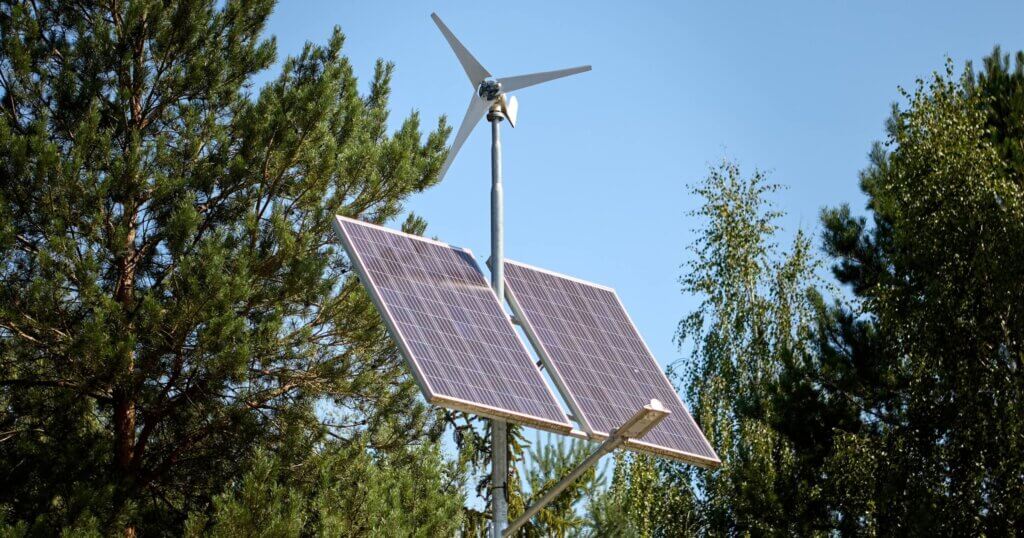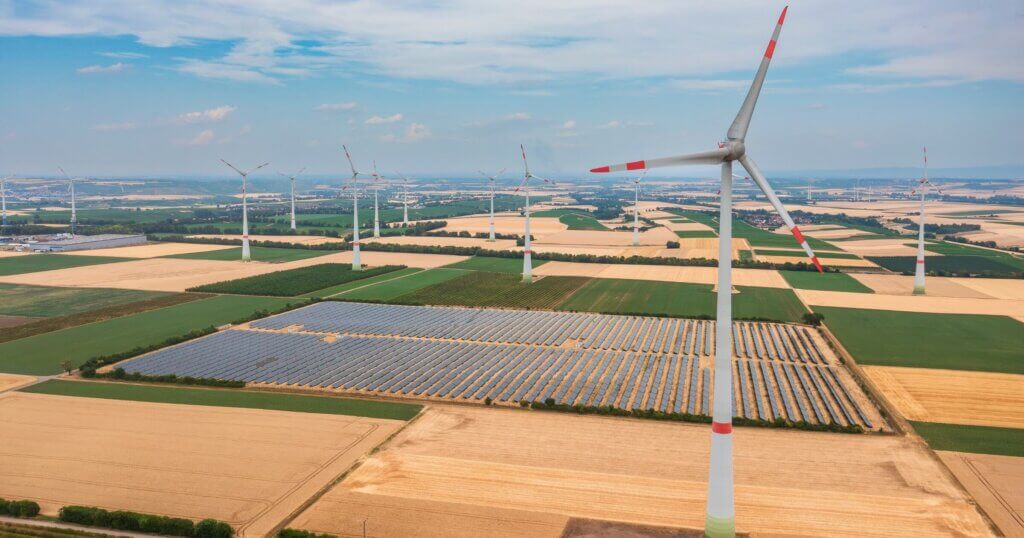If you’re considering building a solar wind farm, one of the first things people want to know is how much it will cost. The answer depends on several factors: the size of the setup, the location of the build, the type of equipment being used, and whether you’re doing it yourself or hiring a contractor. Costs can swing pretty widely, and having a ballpark idea before you get started can make the planning process a lot smoother. In this guide, we’re going to cover the general cost to build solar wind farm and tips to help you budget based on your setup and goals.
Quick look
- Pricing depends on size, materials, and location, ranging from $1,000 for small residential hybrids to over $15,000 for commercial-scale builds.
- Larger farms require more infrastructure; premium materials and professional installs raise costs, while DIY can offer savings for small systems.
- Urban vs. rural placement, regional labor rates, and local permitting rules all affect final project budgets, sometimes significantly.
- Combining solar with wind and battery storage can improve reliability, but it also increases costs and installation complexity.
Solar industry growth projections
Solar energy is powering ahead as a clean, dependable source of electricity, growing faster than ever before. Global deployments and energy markets are rapidly shifting, driven by falling costs, policy support, and increasing demand.
Global and regional trends
Around 597 GW of new solar capacity was installed worldwide in 2024, bringing the total solar PV capacity to 2.2 TW. In 2025 alone, installations may rise to around 655 GW. They expect annual installations to reach 1 TW by 2028 and total global solar capacity to exceed 7 TW before 2030.
In the United States, solar continues to boom. The solar industry installed 10.8 GW–dc of capacity in Q1 2025, and in 2024, solar and storage accounted for 84% of all new electricity-generating capacity, with solar alone adding a record 50 GW. Solar accounted for 66% of all new electricity generation capacity added in the U.S. in 2024.
Globally, solar continues its upward trend. In 2024, clean energy, led by solar, surpassed 40% of the world’s electricity generation for the first time since the 1940s. Solar capacity building is underway; Ember forecasts that the world is on track to install 593 GW by the end of 2024, 29% more than in 2023.
What this means for energy and industry players
All this growth means that solar power is becoming a dominant force in energy. For contractors, developers, and investors, this means more opportunities than ever to build and finance solar farms.
Where solar leads, the planning calls for more innovative designs, better materials, and innovations like battery integration. For energy supply, solar’s expansion is helping shrink fossil fuel reliance, meet growing electricity demand, and support the grid’s transition, especially as technologies like AI, EVs, and data centers ramp up usage.
Solar farms will likely become even more competitive as costs fall and capacity soars. Technology improvements, grid upgrades, and policy support could further boost production and cut project prices, making solar farming a wise choice for energy and business alike.
How much does it cost to build a solar or hybrid wind farm?
There’s no single price tag for a solar or hybrid wind farm. The cost depends heavily on the scale of your system, where it’s being built, the type of equipment you use, and whether you’re powering a cabin, a business, or an entire community.
For small, off-grid hybrid systems, like those used for cabins, farms, or residential microgrids, costs typically range from $1,000 to $15,000 USD or $1,500 to $20,000 CAD. These setups might include a few solar panels, a small wind turbine, and basic battery storage.
However, commercial-scale projects are in a different ballpark.
- Solar farms are usually priced by the watt, with costs averaging $0.90 to $1.30 USD per watt. A 1 MW utility-scale solar farm could cost between $900,000 and $1.3 million USD.
- Wind turbines add significantly more. A single large turbine can cost $1.3 to $3.1 million, depending on the model and capacity.
If you’re planning a full-scale solar or wind farm for commercial or utility use, expect to budget in the hundreds of thousands to millions, not thousands.
What drives the difference in cost?
Smaller systems come in at a lower price because they require fewer components: maybe a dozen solar panels, a compact inverter, and a basic wind turbine. These systems often power remote homes, outbuildings, or hobby farms.

Photo courtesy of https://www.shutterstock.com/
Larger projects, those tied to the grid or powering commercial operations, require far more infrastructure. This includes extensive racking systems, larger inverters, energy storage, and sometimes miles of cabling or land prep. Costs rise quickly with size, especially when battery storage or utility interconnection is part of the plan.

Photo courtesy of https://www.shutterstock.com/
Adding wind to the mix can improve reliability in areas where sunlight isn’t consistent, but it also increases equipment and installation costs. That’s why many large-scale hybrid systems are custom-designed based on the site, climate, and energy needs.
Commercial scale cost context
When comparing build costs, residential and small hybrid systems can seem quite affordable, but large-scale wind and solar farms play in a totally different league. To make sense of the numbers, it helps to switch to a dollars-per-watt basis and consider scale.
Wind turbine costs
A modern commercial-scale wind turbine usually costs between $1.3 million and $2.2 million per megawatt (MW) of installed capacity. Given that most turbines produce anywhere from 2 to 3 MW, that brings the per-unit cost to roughly $3 million to $4 million.
Commercial solar costs
Utility-scale solar farms average $0.90 to $1.30 per watt, which translates to $900,000 to $1.3 million per MW, or $300,000 to $500,000 per acre. Meanwhile, many commercial rooftop or industrial installations fall in the range of $1.46 to $1.83 per watt.
Why dollars-per-watt makes sense
Smaller systems, like residential hybrids and off-grid farms, look affordable when expressed in flat dollar amounts. But those figures don’t translate to utility-scale pricing. For larger projects, including commercial solar or wind farms, it’s clearer to compare costs using the $/W metric. That way, you can see how scale, economies, and equipment bring costs down per unit of power produced.
From DIY hybrids to utility-scale setups
| Project type | Typical size | Cost basis | Estimated total cost* |
| Residential Hybrid System | ~1 kW | Flat cost | $1,000 – $5,000 USD |
| Off-grid / Small Farm | Few kW | Flat cost | $5,000 – $10,000 USD |
| Commercial Solar Farm | 1 MW | Utility-scale solar: $0.98/W | ≈ $980,000 USD |
| Utility-Scale Solar | 1 MW | Solar range: $0.80 – $1.60/W | $800,000 – $1.6M USD |
| Larger Commercial Solar | 5 MW | Example breakdown: $2.50/W | ≈ $12.5M USD |
| Commercial Wind Turbine (Onshore) | 1 MW capacity | Installed cost: $770 – $850/kW | $770,000 – $850,000 USD |
| Commercial Wind Turbine (2–3 MW) | 2–3 MW | Per turbine total: $2.5 – $4 M | $2.5 – $4 million USD each |
*Costs are generalized estimates and don’t include variables like land acquisition, grid interconnection, or soft costs.
Factors affecting the cost of a solar wind farm
Figuring out how much your solar wind farm might cost isn’t always straightforward. It’s not just about choosing panels or turbines. A number of factors can affect the final number, and one of the biggest is the size of your system.
Size: Bigger builds = higher cost
If you’re aiming for higher energy output, expect the cost to climb as well. Bigger systems need more panels, more turbines, and a lot more room to set everything up. You’ll also have to pay for additional equipment, such as mounting racks, larger inverters, and the necessary electrical work to connect everything properly.
For example:
- A compact solar‑wind hybrid kit, typically in the 600 W to 1 kW range, can be purchased for roughly $2,000 to $4,000 USD, making it a feasible choice for cabins, tiny homes, or RVs.
- Medium-sized off-grid systems, such as basic DC setups for cabins, RVs, or light business use, typically range from $5,000 to $10,000 USD, depending on your site and equipment choices.
- A large commercial or community-scale farm with multiple rows of panels and several wind turbines could easily push beyond $15,000 USD, especially once you add in battery storage or grid interconnection.
The more energy you plan to produce, the more infrastructure you’ll need to install, monitor, and maintain. That includes clearing and grading land, pouring concrete bases, installing fencing, and meeting regulatory or utility requirements, all of which scale with size.
Materials: Budget vs premium options
What you build with matters. The panels, inverters, mounts, and other hardware you pick will affect how much you spend and how well the system holds up over time. Some options are more budget-friendly, while others are built to last longer or produce more power.
Solar panels
If saving money is your primary goal, polycrystalline panels may be the best option. They’re cheaper than high-end options and work just fine if you’ve got enough space to install more of them. You might not achieve the same power output in a tight space, but for larger areas or budget builds, they’re often sufficient.
If you’re looking to maximize energy output from a smaller footprint, monocrystalline panels are a better choice. They’re more efficient and hold up well over time. Some systems even use bifacial panels, which can pick up extra sunlight from below if the surface reflects light back up.

Photo of monocrystalline solar panels in a field. Courtesy of https://www.shutterstock.com/
Premium panels cost more upfront, but they make sense if space is limited or you need more output from fewer panels.
Supporting structures and hardware
Panels aren’t the only thing that affects your final price. You’ll also need to think about inverters, mounting systems, wiring, and, if you’re adding wind power, the towers or support structures that come with it. The cost for these parts can vary quite a bit, depending on how simple or advanced your setup is and how long you want it to last.
Inverters
For smaller or more straightforward systems, a basic string inverter is usually enough. It’s affordable and gets the job done. If you’re after detailed system monitoring or future upgrades, a smart inverter with extra features may be worth the extra cost.
Mounting systems
If your site is flat and easy to build on, standard aluminum or steel racks should be fine. They’re dependable and less expensive. Uneven ground or sloped areas may require adjustable or specialized racking, which can add to the budget.
Wiring and connectors
Most setups use copper wire with basic weather protection, which works in many locations. But in areas with extreme weather or long-term exposure, it’s better to use UV-resistant, corrosion-proof wiring to help prevent damage and reduce maintenance.
If you’re building on a tight budget, these standard options can still work well. However, if your goal is fewer issues over time, spending a little more now can result in a more durable, lower-maintenance system.
Complexity: Simple vs custom design
A straightforward, grid-connected solar wind farm on flat land is usually cheaper to design and install. These setups follow standard layouts, which means less planning, less equipment customization, and faster installation.
On the other hand, custom designs are often needed for sites with uneven terrain, tricky weather patterns, or specific performance goals. These projects may require specialized mounting systems, advanced monitoring technology, or hybrid configurations that blend wind, solar, and storage. All of that adds complexity and cost.
If your site needs additional engineering or a creative layout to maximize sun and wind exposure, expect both design fees and construction costs to rise accordingly.
Labor: DIY vs contractor pricing
If you have experience with electrical or construction work, installing the system yourself could help you save money. Smaller systems, in particular, are more manageable for DIY projects, and you can potentially cut costs by 30 to 50% compared to hiring a professional crew.
Still, DIY projects often take more time. You may need to rent tools, handle permits yourself, and troubleshoot unexpected issues. For someone tackling this for the first time, it can be a lot to take on.
Hiring a contractor will likely cost more at the start, but there’s value in having someone who knows what they’re doing. Professional installs usually go faster, follow local rules, and often come with warranties or support if anything goes wrong later.
Location: Regional differences
Where you decide to build has a big impact on how much the project will cost. Prices shift depending on how easy it is to get labor, materials, permits, and access to the grid.
If you’re working in a city, expect to pay more. Land is limited, labor rates tend to be higher, and zoning rules can be strict. Rural areas usually offer more space and cheaper labor, but you might need to spend more on clearing land or connecting to power lines.
There are also differences from one country to another. In the U.S., sunny states like Texas, Arizona, and Nevada tend to have lower solar costs. Good weather, lots of open land, and competitive labor markets all help keep prices down. In Canada, projects often cost more. Shorter winter days, colder conditions, and fewer suppliers in remote areas can all raise the price.
Permits: Local building code requirements
Permits are an unavoidable part of any solar wind project. Costs vary depending on location, but they generally include similar requirements:
- Application and review fees
- Zoning or land-use approvals
- Environmental or noise assessments (especially for wind turbines)
- Inspection charges before and after construction
In some areas, you may also need to apply for interconnection agreements with the utility or register with a provincial/state authority. These steps take time and add to the overall budget, so it’s worth researching requirements early.
Other factors
Beyond the basic costs, there are other factors that impact your final price:
- Energy storage integration: Adding batteries is a smart move if you want to store extra power or improve your energy supply. However, it does add to the overall cost. Most systems utilize lithium-ion batteries, and the price typically ranges from $ 7,000 to $15,000, depending on the storage capacity required.
- Environmental assessments: Some regions require environmental reviews for wind turbine installations, especially if they could affect wildlife or migratory birds. These assessments can delay projects and add consulting fees.
- Access roads and site prep: Remote locations may require new access routes, land clearing, or soil stabilization before building can begin. These hidden infrastructure costs can sneak up fast, especially on larger sites.
Things to consider for pricing variations
No two solar wind farms cost the same, even if they look similar on paper. Once you start pricing out your project, you’ll want to keep a few extra variables in mind that can affect your final budget.
Local labor and material cost fluctuations
What you’ll pay for labor and materials depends a lot on where you’re building. In some places, it’s harder to find skilled installers or nearby suppliers, which can raise wages or slow the project down. Materials like steel, concrete, and wiring might also cost more if there’s high demand or if they need to be shipped in from far away.
Sourcing of solar panels and shipping fees
If your panels aren’t available locally, you might have to bring them in from another region or country. That can lead to extra costs for shipping, customs fees, or possible delays. Some suppliers offer bulk discounts or better regional pricing, so it’s worth getting a few quotes before you decide where to buy.
Size and scalability of the farm
Larger farms may benefit from economies of scale, which can lower the cost per kilowatt. But upfront investment will still be higher, and bigger systems often require more planning, permitting, and infrastructure. If you’re starting small with plans to expand later, designing for scalability can save money in the long run, but it may mean higher initial design and equipment costs.
Regional policy incentives or tariffs
In some places, there’s help available to bring your costs down. In the U.S., for example, you may qualify for a federal tax credit that can cover up to 30% of your solar installation costs. Depending on where you are in Canada, there may be local or provincial programs that offer rebates or funding as well.
At the same time, if you’re ordering panels or wind parts from outside North America, be aware that import tariffs could drive up the price. It’s something to check before you buy.
Site-specific considerations
Don’t forget about the land itself. Projects on sloped, rocky, or remote terrain often require extra preparation before construction can begin. Costs for grid connection can also rise significantly if your site is far from existing infrastructure.
Related articles you may also find helpful:
- The world’s largest solar farm now online in China
- Solar energy projects currently under construction
- How Rosendin Electric is using robots for solar installations
- How much does it cost to build a storage facility?
- How much money does a dam cost?
- Highway construction cost in 2025
Subscribe to our newsletter for construction gear reviews, build cost breakdowns, and the latest trends in renewable design.



